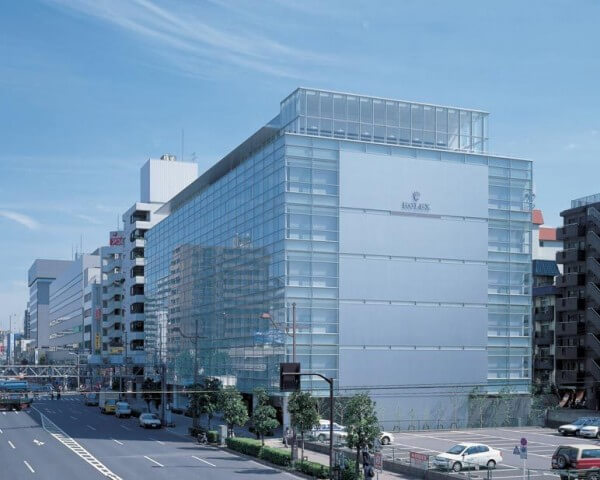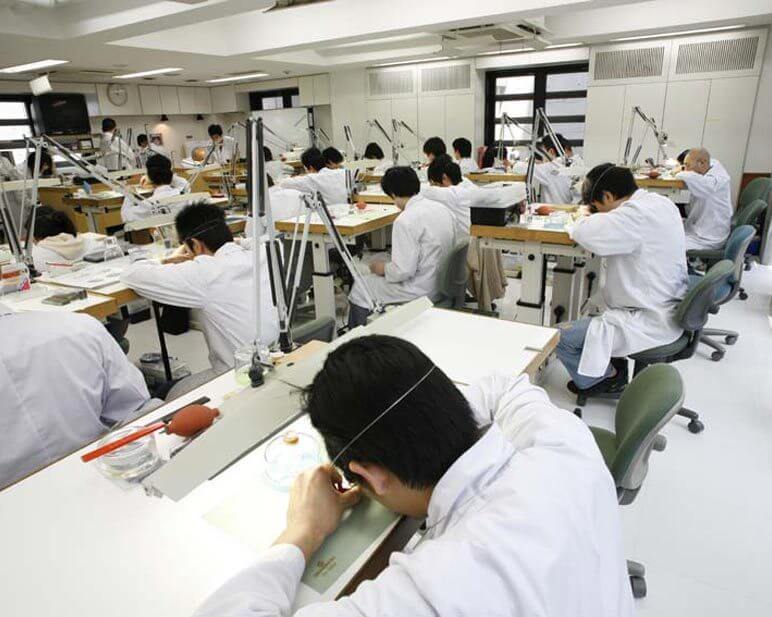In 2007, Japan imported around 1,670,000 watches from Switzerland for a value of approximately CHF 1.207 billion. This is 4.7% less than in 2006. Even though this downward trend in Swiss watch imports has accelerated in Japan, it remains the third most important market after the USA and Hong Kong for the Swiss watch industry. With the exception of complication watches, most subsidiaries and importers try to repair their watches inside Japan so as to reduce time and the cost of servicing and repairs. In order to meet demand, training watchmakers is a serious matter in Japan.
There are three watchmaking schools in Japan. However, their purpose is not actually to teach students how to make watches but how to repair them. This article will look at the two major schools in Tokyo: the Hiko Mizuno Watchmaking School and the Tokyo Watch Technicum.
Hiko Mizuno Watchmaking School
Hiko Mizuno Watchmaking School is part of Hiko Mizuno Jewelry College, founded in 1966. In 1994, the Japan Watch Importers Association asked the college to set up a watch repair course, given the shortage of watchmakers who knew how to repair Swiss mechanical watches. In those days, while the quantity of watches imported from Switzerland had increased, it was hard to find young watchmakers with sufficient skills to repair mechanical watches. Of course, the development of quartz had an impact. In 1996, Hiko Mizuno Jewelry College launched the Hiko Mizuno Watchmaking School. Three years later the school launched a WOSTEP course, making it the first WOSTEP partner-school in Asia.
Today, Hiko Mizuno Watchmaking School employs 25 teachers and runs three courses: a two-year course (80 students), a three-year master course (60 students) and a three-year WOSTEP course (70 students). The average age of students is 26 and 80% of students are men. Furthermore, 70% of students entered the school after gaining several years’ work experience. According to Mr. Fumio Ishizaki, a director of Hiko Mizuno Watchmaking School, most of the students have no background in watches, they simply like working with small things.
Since the WOSTEP course started in 1999, 115 students (of which 87% are men) have been awarded a WOSTEP certificate. They went on to positions in the after-sales service departments of Rolex Japan, Patek Philippe Japan, Richemont Japan, Swatch Group Japan and other importers, as well as some watch repair specialists.
“Our school is the only and largest private technical school in this field approved by the Tokyo Metropolitan government and the Japan Watch Importers Association. We have an intake of 95 students each year, and over 500 students have graduated from the school since it opened. They now make up an important workforce for watch importers, repair specialists, retailers and antique watch shops. Each student pays ¥1,500,000 (~ USD 14’500.-) annual tuition fees, which is our only income to run the school. Our school is located in Shibuya, which is a very popular place among the young generation and easy to access by rail, subways and bus. But Shibuya is in the center of Tokyo and it is impossible to get a large lot for a school facility. Because of this, we cannot give our students enough space for training compared with Switzerland. This is our problem,” said Mr. Ishizaki.
Tokyo Watch Technicum
Another WOSTEP partner-school, Tokyo Watch Technicum, was established in April 2003 and is run by Rolex Japan. The school is housed in a large, modern building belonging to the Rolex Japan Service Center in an eastern part of Tokyo. Despite sharing the same building, Tokyo Watch Technicum is independent from the Rolex Japan Service Center and students cannot visit other floors except their training rooms. Students complete the 3,000-hour WOSTEP curriculum in two years whereas Hiko Mizuno’s WOSTEP course lasts for three years. Tuition fees are ¥1,050,000 (~ UDS 10’200.-) per year plus ¥315,000 (~ USD 3’000.-) for tools and other necessary material.

So far, 29 men and 5 women have completed the course and been awarded the WOSTEP certificate. They now work for Rolex Japan, Richemont Japan, Breitling Japan, Audemars Piguet Japan, Chopard Japan, Bovet, and others.
“We have a maximum intake of 12 students each year. I would describe our curriculum as very strict. Classes begin each day at 8.30am and finish at 5.30pm and we teach each student based on his or her ability, meaning some students progress faster than others. Because we put particular emphasis on micromechanics, during their first year students learn in detail how to make tools and small parts. Our school and atmosphere is based on the WOSTEP standard and I am very proud of our world-class level. We really hope to train future leaders for the Swiss watch industry,” said Ms. Masayo Hadate, the principal of the school.
Ms. Hadate, a watchmaker who trained in Switzerland, describes the current situation in Japan: “Unlike in Europe and the United States, there is much room for improvement in the Japanese watch industry. Regrettably, watchmakers are not held in high esteem in Japanese society. We hope our graduates will put their outstanding skills and expertise to practical use and contribute greatly to improving the social standing of watchmakers in Japan.”
Even though the number of watch imports has decreased, skilled watchmakers are always in demand. However, the economic situation in Japan is another problem and both schools have difficulties finding positions for their graduates.














